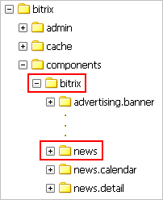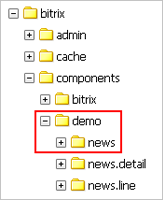Last Modified: 10.10.2024
|
|
|
Views: 13057
Last Modified: 10.10.2024 All components are stored in the /bitrix/components/ folder. The system components are in the /bitrix/components/bitrix/ folder. The content of this folder is updated by the update system and must not be modified by users. Note! Modifying the system component folder /bitrix/components/bitrix/ can have unpredictable effects.
Users can store their own components in any subfolder of /bitrix/components/, or in the /bitrix/components/ root. 
Naming conventionThe name of a subfolder in /bitrix/components/ is the component namespace. For example, all system components belong to the bitrix namespace. When creating a custom component, you should create a namespace and put custom components there. For example, a system component news exists located in the bitrix namespace. If you need a custom news component implementing functions unavailable in the standard system component, you should create a namespace (subfolder) in /bitrix/components/ (for example, demo) and put the custom component news there. The two components news will be available in different namespaces: bitrix:news and demo:news; both of them will be shown in the component tree in the visual editor.
Names of the components are as follows identifier1.identifier2…. For example, catalog, catalog.list, catalog.section.element, etc. The names should be built hierarchically starting from the general term and ending with specific purpose of the component. For example,the component showing the list of goods of this group may have the name catalog.section.elements. The full name of the component is the name of the component indicating the namespace. The full name looks like name_space:component_name. For example, bitrix:catalog.list. If the component is located outside the namespace, the namespace will not be specified. For example, catalog.section. Component ConnectionIn the most general terms, the component connects as follows: <?$APPLICATION->IncludeComponent( componentName, // component name componentTemplate, // component template, empty line if default template is used arParams=array(), // parameters parentComponent=null, arFunctionParams=array() );?> The following preset variables are available inside the component (file component.php):
Courses developed by Bitrix24
|

